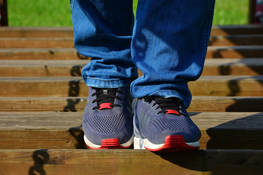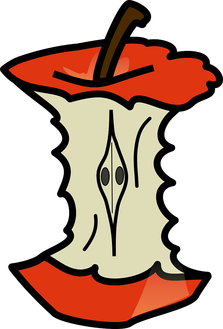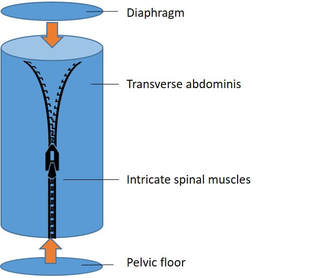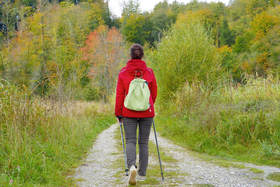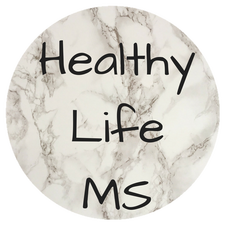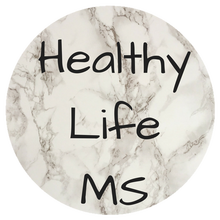'Improving core strength' has been the latest trend/buzz-term in fitness and gym circles for what seems like years (so much so that it can't really be termed the 'latest trend' anymore) so you would be forgiven for thinking that a strong core can solve anything! It can't unfortunately, but a strong core is important to maintain posture and balance in everyone, not just those of us with MS (I'll cover posture in a future post).
The importance to us though, is that MS can mean that balance can become problematic; research shows that as many as seven out of ten people with MS (PwMS) experience balance problems at some point during the course of the condition, with around one in five people reporting balance problems as one of their first symptoms of MS.
The importance to us though, is that MS can mean that balance can become problematic; research shows that as many as seven out of ten people with MS (PwMS) experience balance problems at some point during the course of the condition, with around one in five people reporting balance problems as one of their first symptoms of MS.
It may sound silly, but why is balance important?
In pre-MS days whilst studying for my MSc I wrote a piece on osteoporosis and the importance of maintaining bone strength. Much of this research focussed on preventing falls causing breaks at high-risk sites like the hip, wrist and spine and the importance of balance training in helping to prevent potential falls. I carried on to learn much more about functional training for improving balance through my PT qualifications and understood that balance is definitely something we can train for regardless of age or ability.
Balance is important primarily to prevent falls, but also (as we all probably already know!) in day to day living; no-one wants to trip down the stairs (or up as I did recently) or to fall over nothing.
How can MS be responsible for balance issues?Do you remember the 'tangled wires' analogy from the site? This is where messages sent from the brain to the muscle to perform a specific action get jumbled up and don't necessarily reach the desired destination, get misinterpreted along the way or are too weak to elicit the required action; it maybe that the brain orders the foot to be lifted in order to clear a kerb, but if the message doesn't get through, you'll trip up the step.
Many of our MS symptoms can bring about unsteadiness and balance problems, increasing the chance of tripping or falling, including:
Balance is important primarily to prevent falls, but also (as we all probably already know!) in day to day living; no-one wants to trip down the stairs (or up as I did recently) or to fall over nothing.
How can MS be responsible for balance issues?Do you remember the 'tangled wires' analogy from the site? This is where messages sent from the brain to the muscle to perform a specific action get jumbled up and don't necessarily reach the desired destination, get misinterpreted along the way or are too weak to elicit the required action; it maybe that the brain orders the foot to be lifted in order to clear a kerb, but if the message doesn't get through, you'll trip up the step.
Many of our MS symptoms can bring about unsteadiness and balance problems, increasing the chance of tripping or falling, including:
- Muscle stiffness/weakness causing unsteadiness
- Muscle spasms/spasticity/tremor putting us off-balance
- Numbness interfering with how we walk
- Vertigo affecting perception
- Pain affecting mobility
- Visual problems affecting how we perceive obstacles
- Fatigue
First cautionary note...
...not all balance problems are a result of your MS, if things change or are different to your 'normal' consult your medical team for advice.
What is the core and what does it have to do with balance?
The core is considered the main trunk of the body once the arms and legs have been removed. A strong core (or core stability) allows us to maintain balance when moving a limb away from the body eg reaching for something on a table or walking; muscles working around the core allow for and correct this imbalance to keep us upright.
The core musculature can be visualised as a non-compressible cylinder with the diaphragm at the top, the pelvic floor at the bottom; the transverse abdominis (which compresses the abdominal contents and maintains pressure to protect the spine) wrapped around the sides, all zipped up by the intricate muscles surrounding the spine.
The core musculature can be visualised as a non-compressible cylinder with the diaphragm at the top, the pelvic floor at the bottom; the transverse abdominis (which compresses the abdominal contents and maintains pressure to protect the spine) wrapped around the sides, all zipped up by the intricate muscles surrounding the spine.
Layers of the coreMuscles which support the trunk are arranged in three layers - deep, middle and superficial (outer) - and work together to maintain spinal stability and balance. Often when talking about the core people mistakenly assume we are talking about a visible 'six-pack' or sculpted oblique muscles to pull in and define our tummies. These muscles are an important part of the core but as large (outer) muscles, they are primarily responsible for gross movements such as bending and twisting while other smaller, deeper muscles such as those surrounding the spine play a larger role in subtle movement to maintain balance. The main goal of core stability is keeping the spine supported and protected; without this musculature the spine is inherently unstable putting us at risk of injury. The three layers of muscles surrounding the trunk work together to wrap around the body to allow stability when we move limbs when walking, stretching, leaning etc; any movement which puts the body out of balance.
There are many muscles involved in core stability, some major ones include:
Deep muscle layer
Middle muscle layer
Outer muscle layer
The core's function is primarily to support and protect the spine while we do activities with the attached limbs eg walking etc in an attempt to throw it off balance!
There are many muscles involved in core stability, some major ones include:
Deep muscle layer
- Series of intricate muscles surrounding the spine
Middle muscle layer
- cylinder image above
Outer muscle layer
- Abdominal ,muscles
- Oblique muscles (internal and external) which allow spinal rotation and a degree of forwards and backward bending
- Gross spinal muscles
- Gluteals
The core's function is primarily to support and protect the spine while we do activities with the attached limbs eg walking etc in an attempt to throw it off balance!
What can I do to strengthen my core?Now we've covered what the core actually is and the importance of using movements which work on all three muscle layers, you can hopefully see that a core training plan isn't just a load of abdominal crunches/sit-ups each day - although, with proper form these can play a role...
...and this is always the challenge of writing about exercise but not providing a training plan for you to follow; it is very difficult to provide personalised training through a blog post or even through an online video (remember my rotator cuff injury of a few years ago?!). Personal Training is by nature 'personalised'; what works for me isn't necessarily suitable for anyone else. I could provide links to a video of core exercises but without knowing you personally I can't find out if they are suitable or whether they will aggravate existing conditions; some core exercises are tricky and need coaching into position, difficult from behind an email. For example, the plank is a traditional core exercise, but unless you have been shown the correct way to perform it, it can give you dreadful back-pain and provide little benefit.
What I can do though is add a link to core and balance exercises provided by the MS Trust; these have been shown helpful for many abilities and are promoted within their site. If I can work out how to create the little moving figures perhaps next time I can add some of my own!
Exercises for core stability
Balance for everyday activities
There is a large part of PT-ing which focusses on improving your functional ability in order to perform your daily activities with less energy and effort. Many of our daily activities eg walking, wheeling, carrying groceries, reaching for items on a table or shelf etc will automatically use your core strength already; there is a 'principle of training' around specificity ie train at performing specific tasks in order to be better at them or to make them easier; so rather than setting out to have the 'strongest core ever' why not focus on specifically making daily tasks easier - the more you do something the easier it becomes. Practice intentionally reaching up to pick something off a high shelf, practice balancing to walk along a line at home (a floorboard in the kitchen is my favourite) practice standing on one leg (if you do that a lot!) etc; rehearsing daily activities may provide more benefit than worrying about specific exercises.
Final cautionary note
Core strength isn't the only thing responsible for improving balance; exercises such as Tai Chi, yoga and pilates are also suggested (which arguably rely on training a degree of core strength too)
Please consult a physiotherapist or book a session with a PT to assess which exercises are most suitable and give you a step-by-step guide. As always, safety when exercising is paramount.
Please consult a physiotherapist or book a session with a PT to assess which exercises are most suitable and give you a step-by-step guide. As always, safety when exercising is paramount.
References:Active IQ (2016) Fitness instructing manual: gym. London: Active IQ
Active IQ (2016) Personal training manual. London: Active IQ
Cash M (1999) Pocket atlas of the moving body. London: Ebury press
Freeman, J.A Et al., (2010) ‘The effect of core stability training on balance and mobility in ambulant individuals with multiple sclerosis: a multi-centre series of single case-studies’, Multiple Sclerosis 0(00): 1-8. Doi: 10.1177/1352458510378126
Kanis, J. A., McCloskey, E. V., Johansson, H., Cooper, C., Rizzoli, R. and Reginster, J. Y. (2013) 'European guidance for the diagnosis and management of osteoporosis in postmenopausal women', Osteoporosis International, 24(1), pp. 23-57. doi: 10.1007/s00198-012-2074-y.
MS Society (2016) Balance and MS (booklet). Available online at: https://www.mssociety.org.uk/ms-resources/balance-and-ms-booklet
MS Trust (2016) A-Z of MS: Balance. Available online at: https://www.mstrust.org.uk/a-z/balance
Active IQ (2016) Personal training manual. London: Active IQ
Cash M (1999) Pocket atlas of the moving body. London: Ebury press
Freeman, J.A Et al., (2010) ‘The effect of core stability training on balance and mobility in ambulant individuals with multiple sclerosis: a multi-centre series of single case-studies’, Multiple Sclerosis 0(00): 1-8. Doi: 10.1177/1352458510378126
Kanis, J. A., McCloskey, E. V., Johansson, H., Cooper, C., Rizzoli, R. and Reginster, J. Y. (2013) 'European guidance for the diagnosis and management of osteoporosis in postmenopausal women', Osteoporosis International, 24(1), pp. 23-57. doi: 10.1007/s00198-012-2074-y.
MS Society (2016) Balance and MS (booklet). Available online at: https://www.mssociety.org.uk/ms-resources/balance-and-ms-booklet
MS Trust (2016) A-Z of MS: Balance. Available online at: https://www.mstrust.org.uk/a-z/balance
